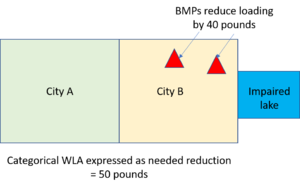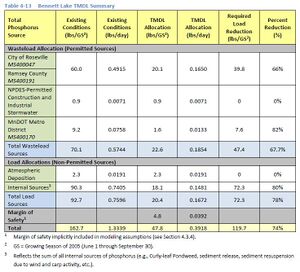
Guidance for categorical TMDLs
Many total maximum daily loads (TMDLs) lump multiple wasteload allocations (WLA) for MS4 permittees into a single WLA. This single WLA is called a categorical WLA. This page provides guidance to MS4 permittees for interpreting categorical WLAs.
Contents
Advantages and disadvantages of categorical WLAs in TMDLs
The primary advantage of a categorical WLA is that it provides a single value that all permitted MS4s can work toward achieving. This provides greater opportunity to implement pollution reduction practices efficiently. Examples include the following.
- BMPs can be implemented in locations that are most cost efficient and most effective
- Cooperative implementation of BMPs is encouraged
- A single entity, such as a watershed district, can act as an aggregator of pollution reductions
Categorical WLAs have disadvantages.
- Responsibilities for individual permittees are unclear
- Permittees that have been aggressive in stormwater management are lumped with permittees who have done limited stormwater management
Addressing categorical WLAs
Prior to the 2020 MS4 General Permit issuance, it was not necessary to derive an individual waste load allocation (WLA) for a total maximum daily load (TMDL) that used a categorical MS4 (Municipal Separate Storm Sewer System) wasteload allocation (WLA), unless a permittee was claiming to meet a categorical WLA. This permit cycle, in order to make a determination as to whether permittees may or may not be meeting a WLA, they may need to derive an individual target load.
Permittees can work together to cumulatively meet required pollutant loads or pollutant load reductions. However, if a permittee chooses to derive its own pollutant target, there are several options. This section provides guidance for cumulatively meeting a categorical WLA or deriving an individual target.
Cumulatively meeting a categorical WLA
Permittees can work together to meet a categorical WLA. This is a favored approach if the following conditions exist.
- There is an entity that can act as an aggregator. An aggregator tracks implemented activities and associated pollutant reductions or pollutant loads. Watershed districts often can function as an aggregator.
- Funding options for BMP implementation are flexible and can be applied toward selecting the most effective practices and locations for implementation. Because permittees can take credit for activities implemented within the watershed of concern by different entities (e.g. different permittees) when meeting a categorical WLA, funds can be focused on projects that achieve the greatest benefit at the lowest cost. Watershed districts are one mechanism for funding projects that are most cost effective. Grants and low interest loans are other examples of funding that can be gained when permittees work together to implement the most cost effective BMPs. Trading between permittees may be another option.
In Figure 1, two cities work cooperatively to implement two BMPs close to the impaired water, where they are most effective. Both cities can apply the reductions toward their permit requirements provided the permittees mutually agree to do this.
Categorical WLAs and the 2020 TMDL Application Form
Option 1: Use the percent reduction found in Column I of the Applicable WLAs determination tab as the metric to determine if a WLA is being met or not. (The Simple Estimator provides percent reductions when BMPs are entered). If Column I shows “Insufficient data” or “Not Available” proceed to Option 2, 3 or 4. (If there are multiple flow zones, target the mid-range. See Interpreting wasteload allocations based on flow/load duration curves for more information).
Option 2: Using an aggregator - All permittees sharing a categorical WLA agree to use an aggregator (watershed district or another permittee who agrees to track BMPS and reductions). Use all BMPS since the baseline year and entire MS4 regulated area as outlined in the TMDL to determine whether they are meeting the WLA as a whole or not.
If a group of permittees agrees to address a categorical WLA together, they do not need to determine individual target loads. However, they are all equally responsible for items in the compliance schedule. Each permittee stills need to submit their TMDL Application Form. Categorical WLAs that are being addressed as a group should be noted in question 174 of the PDF portion of the application, and the partnerships should be noted in questions 6 and 7 of the PDF portion of the Application. Permittees are encouraged to submit additional spreadsheets or documents if that assists in tracking BMP ownership or partnerships.
Option 3: Use loading rates found in this spreadsheet.
MPCA staff have determined loading rates (lbs/ac/yr) that can be used for the following TMDL projects which did not have percent reductions listed in the TMDL Application Form.
Burandt Lake Excess Nutrients TMDL
Elk River Watershed TMDL
Golden Lake TMDL
Hardwood Creek Impaired Biota and Dissolved Oxygen TMDL
Lower Cannon River Turbidity TMDL
Miss. River - Saint Cloud WRAPS 2009
South Metro Mississippi TSS TMDL
Twin (Upper, Middle, and Lower) and Ryan Lakes TMDLs
Zumbro River Watershed Turbidity TMDL
Option 4: Permittees individually determine whether they are meeting their portion of the categorical WLA after identifying their target load. (See more information on how to determine this below).
Determining a target load
If a permittee is part of a categorical WLA but wants an individual target load, there are several methods to calculate the target load. Permittee's should reference the wasteload allocation methodology section of the associated TMDL report in order to figure out how to derive their target load. Note that target loads are not approved WLAs. Permittees should consult the MPCA when developing target loads. The MPCA has geographic information systems (GIS) TMDL project area shape files that could be useful in estimating an MS4's portion of the categorical WLA. Available GIS files can be found here. The following approaches explain different methodologies that might be referenced in a TMDL report.
- Area approach. The area approach is the simplest approach. The WLA can be divided based on the area of each MS4. Only areas within the TMDL impaired watershed should be considered. Refer to the associated TMDL report for the specific area approach used in developing the WLA. They may have used any of the following three methods:
- Entire jurisdictional area: Using the full jurisdictional area of a city or other type of MS4 results in the largest regulated MS4 area and requires the lowest level of effort to define the regulated area.
- Land use or land cover: Based on data such as the National Land Cover Database (NLCD), the area within the jurisdictional or property boundary identified as impervious or developed was used to approximate the regulated area. Alternatively, land use or planned land use data such as the Metropolitan Council’s Regional Planned Land Use data for the Twin Cities metropolitan area could have been used to approximate the regulated areas.
- Delineation: The area that is in the jurisdictional or property boundary and that drains to a regulated MS4’s stormwater conveyance (e.g., stormsewers, roadside ditches). This entails delineating the drainage areas to stormwater conveyance within the municipal jurisdiction. The direct drainage areas to public waters should have been excluded from the regulated area. Whereas this approach is the most accurate estimate of the regulated area, delineation requires the highest level of effort and is typically not feasible for a TMDL project if the information was not already available. The approach may have been used if the MS4 area that drains to an impaired water body was relatively small, or the permittee was directly involved in the TMLD development.
MS4 Summary for Bennett Lake - Population approach. The WLAs can be divided based on the relative population of each MS4 as established by the most recent decennial census. Only the population living within the study watershed should be considered. This approach is similar to the area approach and may be more desirable if population densities are considered homogenous across all MS4 areas. This approach could be used if the categorical WLA only includes city and township MS4s. This approach should not be used if the categorical WLA contains multiple types of MS4s since some MS4s do not have a population associated with them (e.g. counties, colleges/universities, Minnesota Department of Transporation (MnDOT)). This is not a commonly used method.
- Land use approach. The WLAs can be apportioned based on land use if the loading from the MS4s differs significantly. For example, assume two MS4s have a categorical WLA of 100 lbs/day. MS4 A has an area of 60 acres that includes 60 acres of commercial land use. MS4 B has an area of 40 acres that consists of residential land use. Assume commercial has a loading factor of 2, and residential 3. Multiplying the loading factors by acres gives a value of 120 for MS4 A and 120 for MS4 B. Thus, in terms of relative loading the two MS4s are equal even though MS4 A covers more area. The target loads for eash MS4 would be 50 lbs/day. The MPCA Simple Estimator could be used to determine the existing loading. This is not a commonly used method.
- Model approach. A MS4 can replicate the model used for the TMDL to determine its current pollutant load. This can be compared to the estimate of current load for all MS4s. The fraction contribution from the MS4 to overall loading is multiplied by the overall MS4 WLA to derive the individual target loads for the MS4. This is a highly technical, high effort endeavor.
Link to this table
| Waterbody | MS4 Name | MS4 ID Number | MS4 Area within the contributing watershed (acres) |
|---|---|---|---|
| Bennett Lake | City of Roseville | MS400047 | 632 |
| Ramsey County | MS400191 | 45 | |
| MnDOT Metro District | MS400170 | 55 |
Figure 3 shows that the total WLA minus the WLA for construction and industrial stormwater is 21.7 lbs/yr. According to the table above, Roseville is 86% of the total MS4 area and Ramsey County is 6%, Roseville could assume their MS4 is 86% of the total WLA, so their individual allocation would be estimated to be 18.7 lbs/yr and Ramsey County's estimated WLA would be 1.3 lbs/yr. MnDOT already has an individual allocation of 1.6 lbs/yr.
If this information is not readily available, MPCA Stormwater staff can assist with determining the areas for each MS4 in the watershed area of the TMDL.
How do I know what method was used in the TMDL?
Every TMDL has a section called ‘wasteload allocation methodology’. That section should describe how the wasteload allocation for point sources such as wastewater treatment facilities, construction and industrial stormwater and MS4s was determined. There should be a subheading specifically discussing the MS4 WLA and which of the above approaches were used to calculate the WLA. This section should also state which permittees were included in the categorical WLA. All of this is necessary information in determining target loads.
Other resources
Before calculating target loads, be sure to check your TMDL’s project page for an Implementation Plan. Many of the early TMDL reports had an associated Implementation Plan that provided target loads as well as suggested BMPs.
To find your TMDL Project page- Enter the name of the TMDL in the search box on this page. The WRAPS report may also include helpful implementation suggestions. Check your Watershed webpage to see if a WRAPS report has been completed.
This page was last edited on 23 January 2023, at 14:31.

